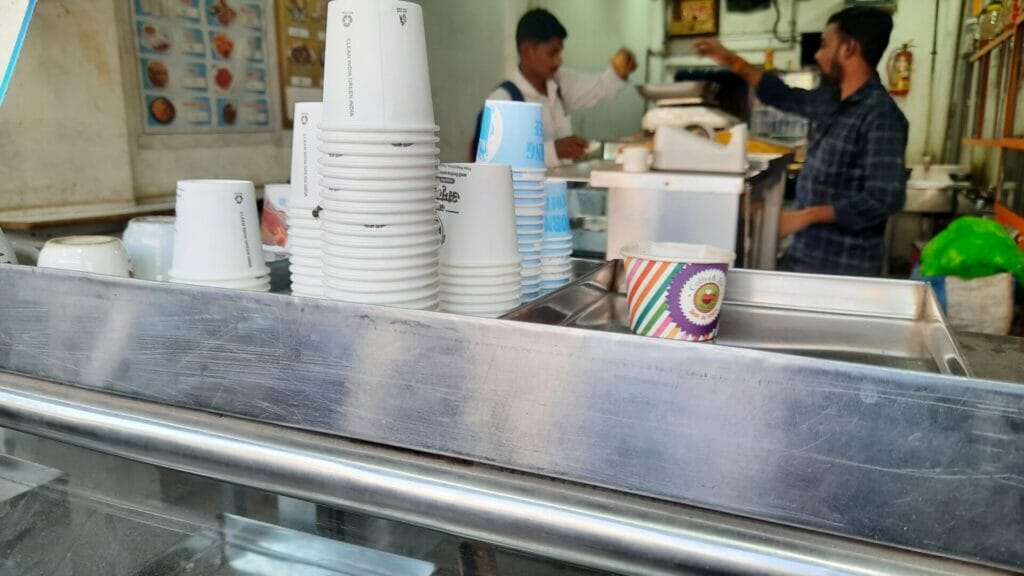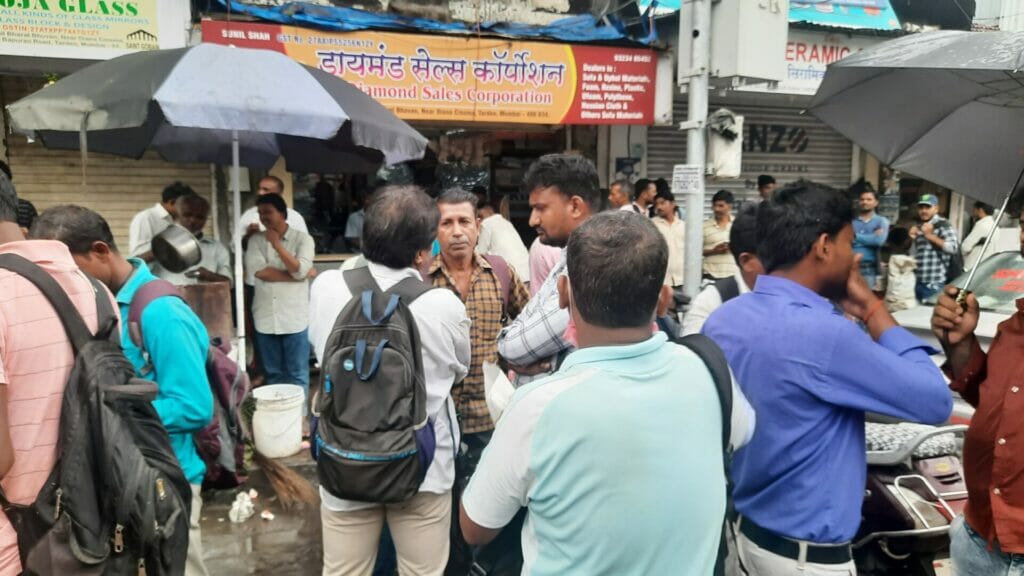“I stay near Kapurbawdi, but travel to Kalyan, Bhiwandi or even Badlapur or Karjat for work”, says Anil, a construction worker from Gulbarga, Karnataka. He’s been a painter for the last 22 years.
Anil is among hundreds of construction workers who gather at 7 am every morning at the labour naka (a stand or intersection of roads) at Kapurbawdi junction in Thane seeking work. The unskilled and semiskilled workers include masons, painters, plumbers, carpenters, tile polishers and loaders, among others.
Mostly temporary or seasonal migrants from Maharashtra and surrounding states, they’re informal workers who receive wages in exchange for short or long term work, but have no fixed employer. They are hired for specific projects by different labour contractors.
The building and construction industry is the second largest employer in the country’s unorganised sector. In Maharashtra, Building and Construction Workers’ Welfare Board (BOCW) is the governing body providing safety, health and welfare for construction workers through various schemes. The Board operates on the cess collected from builders, which is meant to fund medical, financial and other welfare measures for construction workers.
Read more: Heat, dust and other challenges facing construction workers in Mumbai
Labour nakas in the city
Workers gather every morning at these labour nakas – located in different parts of the city – with their tools and equipment such as paint brushes, chisels, saws, hammers, trowels, etc. Most nakas in Thane get around 500 workers per day, according to Anil.
Workers at the Kapurbawdi naka come from neighbouring areas like Majiwada, Yashashri Nagar, Dhokali, Kapurbawdi. Thane alone has several nakas at Kalwa, Jambhli Naka, Kisan Nagar, Shastri Nagar and Kasheli to name a few, and most workers who gather there live in rented accommodations with other workers from their hometowns and some with their families. They largely hail from Karnataka, Andhra, Maharashtra and Uttar Pradesh.
The nakas have plenty of chai shops where workers gather as they wait to be hired by a contractor. Workers are found grouped together linguistically, chatting away while also keeping a sharp watch for contractors to hire them for the day. Hardware shops selling tools and equipment, paints and brushes also surround the naka as workers have to bring and maintain their own tools.
Those who do not find work in the morning return home dejectedly around 12-12:30 pm, sometimes earlier, at other nakas like Jambhli Naka in Thane.
The atmosphere at the nakas then transforms. An otherwise busy, social space where workers smoke beedis, clutching their bags containing dabbas of food to last the day, becomes deserted.

Gender dynamics
Most of the time only around 15-20 women at Thane’s nakas are found looking for work. Some hold their children on one arm and their bag on the other as they wait to be hired, and the reality is that women workers are paid less than their male counterparts and are mainly employed as helpers. Helpers lift cement bags, bricks and do other manual work, all considered ‘unskilled’ work, and hence, low paying.
“I get work only for 8-10 days a month and make around Rs 500-800 rupees per day,” says Kamlebai, a daily wage labourer from Gulbarga, Karnataka who has been working since she was a child. “We always get paid less than men”.
Men involved in skilled work make at least Rs 700-1000 a day. This vast wage disparity reflects the conditions of the women workforce who also return to household chores at the end of each working day.
Relationships with contractors
“Aaj iska kaam ho gaya aur kal dusre ka,” (today someone gets work, tomorrow someone else will) says Anil, indicating that there is no fixed employer, which also means that they are at risk of losing wages if the contractor cheats them. Several workers at Kapurbawdi naka complained that some contractors would employ them and then disappear after the project work was completed.
Workers negotiate hard with contractors, who receive commissions for providing principal employers – these are either big developers or people looking to renovated homes/offices – with workers. There is no typical employer-employee relationship, contractors are simply mediators.
Workers are picked up by contractors in personal vehicles or hired tempos, and are hired by different contractors on different days. Their contact with any single contractor is only as long as the work lasts.
This informal arrangement with the contractor means that workers are often out of work. Shivram, a mason who has been working in construction sites for 35 years now, works for 8-15 days per month on an average and Anil works for 15-20 days. Rest of the month is spent finding work and sustaining oneself with savings.
Institutional help at labour nakas
Shivram adds that the local corporator has not provided any facility at the Kapurbawdi labour naka. Across the city, most nakas are located at busy intersections or roads adjacent to larger junctions, where there are no shelters to wait under. Most workers sit at the entrances of unopened shops, on the few benches available, on road dividers and on the footpath. The majority, however, are forced to stand, taking cover under awnings of shops or under bus stops in case it rains.
Apart from occupational hazards which impact their physical and mental health, they also face extreme weather at the labour nakas every day, further risking their health.


Many workers at Kapurbawdi naka are not registered with the BOCW and do not have access to state welfare schemes. While Workers can visit Worker Facilitation Centers (WFC) to register themselves and seek redressal, access to these centres is still a challenge for those who spend the entire day at work. The utilisation of the cess collected from construction projects has also been poor and several unions have flagged this issue.
As per the inputs from BOCW officials, there are 40 such WFCs in Mumbai Metropolitan Region, but they are not close to the labour nakas and are unevenly distributed in the city. They have registered 35-36 lakh workers so far and the last registration campaign drives at labour nakas were conducted in 2018 as per the officials. The officer stated that districts and municipal corporations have been directed to survey the workers in the state and that nakas must be enumerated.
Officials add that there are plans to set up shelters for construction workers, but there is much to be done to ensure that their work, which is low paying and irregular, is addressed first to understand what can be done beyond welfare schemes. For example, whether such short term employment can be replaced with government empanelled construction work that pays fixed salaries and provides workers with other benefits like insurance and pensions.
Read more: Why government schemes aren’t reaching those who need it the most in Mumbai
Impact of the COVID-19 pandemic
According to Anil, wages are higher in Mumbai as compared to other cities in the country. Skilled workers make more than Rs 700 a day and unskilled workers make around Rs 400-500 a day. Anil earns Rs 700-800 per day painting walls from Yashaswi Nagar to Kapurbawdi junction every morning to seek work.
Shivram shared that the workers at Jambhli naka have reduced by about five times after the pandemic and the wages they earn hasn’t increased either.
They are forced to wait for a van providing charitable food service. Their income also does not leave them much to send to their families back home. Kankaiah, a migrant worker from Karimnagar, Telangana complained that his family thinks that he is living well. “Earlier I could earn at least Rs 10,000-20,000 but now I am not even able to earn much for myself,” says Kankaiah.
Many contractors have also gone home, according to workers gathered at the naka. Several workers claim they too will head home early as they are not finding much work. “Unable to get a “party” for a big project, I only get minor repair work nowadays,” said Shivaiah from Kakinada, Andhra Pradesh.
In comparison, Yadagiri, a contractor who works out of the same naka and hails from Medak in Telangana, earns at least Rs 35,000 for constructing scaffolding with bamboo poles. An indication that the construction workers have been hit the hardest by the COVID pandemic.
Changing dynamics of labour nakas
Unavailability of work has changed the nature of the nakas. Along with construction workers, many nakas now have workers seeking daily wage labour in catering, cleaning and other such areas. Many workers at the Jambhli Naka labour stand were ready to take up any work they are assigned, be it cooking, cleaning, helping, loading or construction work, if it means earning a day’s wages.
“I want to earn at least Rs 400-500, so I take up whatever work I get”, said Prakash Pawar at Jambhli Naka.